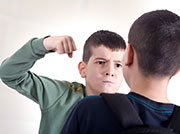
MONDAY, April 28, 2014 (HealthDay News) — Fewer American children have been exposed to violent acts such as assault, bullying, sexual victimization and emotional abuse since 2003, a new study finds.
However, with the recent spate of school shootings, the many discussions of bullying and the fear of child sexual abuse and abduction, it may seem as if the problems are growing, the researchers noted.
“It is easy to conclude from media coverage that things are getting worse,” said lead researcher David Finkelhor, director of the University of New Hampshire’s Crimes Against Children Research Center.
Abductions, family homicides and bullying suicides, however, need to be framed in the context that overall safety for children has increased, he said. “We still have a long way to go, but we should not get discouraged,” he suggested.
Finkelhor believes that these declines in violence are the result of prevention programs, new policing techniques, mental health treatment for aggressive behavior (specifically medication), and parenting education programs.
In addition, technology has helped in several possible ways, Finkelhor said.
“Cellphones allow people to summon help and escape from dangerous situations. Technology records crime, facilitates identification and prosecution, and so deters it. Young people do more of their risk taking online and at home, and it alleviates boredom, which is a big motivator of delinquency,” he said.
Moreover, technology reduces face-to-face encounters that can lead to violence, the researchers added.
The report was published April 28 in the online edition of JAMA Pediatrics.
For the study, Finkelhor’s team collected data from three national telephone surveys of children and parents on children’s exposure to violence in 2003, 2008 and 2011.
Of the 50 specific types of violent and criminal acts that the investigators considered, 27 significantly declined and none significantly increased between 2003 and 2011.
Specifically, since 2003, assaults declined by 33 percent, physical intimidation and emotional victimization dropped by a third, sexual victimization declined by 25 percent and emotional abuse fell by 26 percent. However, between 2003 and 2011, the amount of physical abuse suffered by children hasn’t changed, the study found.
The researchers noted that the rate of violent delinquency was cut almost in half as was the rate of destruction of property. The rate at which children witnessed violence also dropped, the authors said.
The new findings come on the heels of a 10-year study published earlier this month in the American Journal of Public Health that found a drop in bullying rates among U.S. teens.
John Lutzker, director of the Center for Healthy Development at Georgia State University, in Atlanta, co-wrote an editorial accompanying the new JAMA Pediatrics study.
“One case of violence against children is one case too many, but there has been a trend and violence is down,” Lutzker said.
Despite this positive trend, Lutzker said that the United States has more cases of violence against children than most other developed countries: “So it’s not all rosy.”
Lutzker credits a number of factors in reducing violence against children. Public awareness is up, and social norms have changed: Violence is generally considered unacceptable, as is partner abuse and child abuse, he explained.
Moreover, programs to prevent maltreatment of children have been working, Lutzker said. And while social media significantly reduces face-to-face confrontations, cyber-bulling has been increasing, he added.
“There are some very promising trends,” Lutzker said. “But we are far from solving all our problems related to violence.”
More information
For facts on violence against children, visit the U.S. Centers for Disease Control and Prevention.
Copyright © 2025 HealthDay. All rights reserved.

